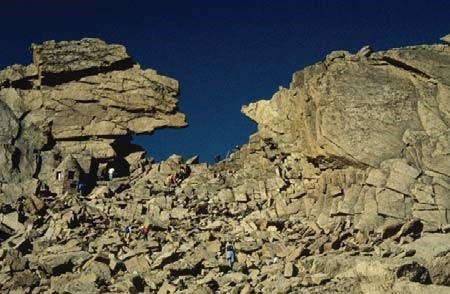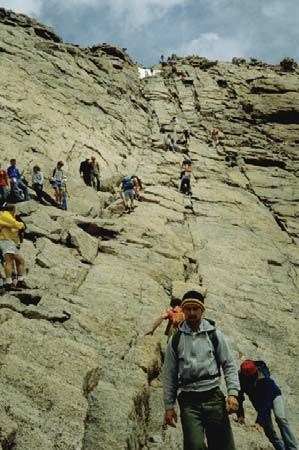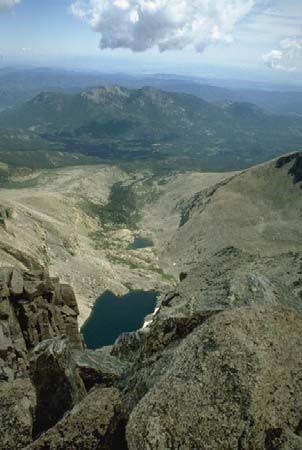Last updated: November 8, 2022
Article
Climbing the Longs Peak Keyhole Route

The Question: How many visitors hike on the East
Longs Peak Trail and how many visitors summit via the Keyhole Route?
Longs Peak is one of the primary scenic attractions of Rocky Mountain National Park. High visitor use along the East Longs Peak trail corridor generates an array of park management issues including public safety concerns, vegetation impacts, trailhead parking, and trail maintenance. Accurate estimates of the visitor use in specific areas of the park are useful in managing these issues and appropriately allocating park personnel and financial resources.Overnight backcountry use can be reliably determined using data from the backcountry camping and bivouac permit system. This study aimed to estimate day use of the park backcountry, which is more difficult to determine.

The Project: Count the number of visitors who depart from the East Longs Peak Trail and hike to the summit of Longs Peak.
From 2002 to 2004, Dr. George Wallace, Matthew Bates, and Jerry Vaske of Colorado State University installed infrared trail monitors at 59 locations in the park backcountry to estimate backcountry visitor use. During 2002, they set up two counters on Longs Peak: one near the East Longs Peak trailhead and one on the “Home Stretch,” which is about 30 feet from the summit along the Keyhole hiking route. The trail monitor near the Longs Peak Trailhead operated from May 30th until October 14th. The Home Stretch monitor operated from July 7th until October 14th.
The Results: The study estimated that approximately 35,000 visitors hiked the East Longs Peak Trail from May 30 to October 14, 2002. An estimated 9,600 of these visitors reached the summit of Longs Peak via the Keyhole Route.
To verifty the count, human observers conducted periodic direct visual counts of human use at the trail monitoring sites in order to develop a calibration ratio for the trail monitor equipment. The trail monitors experienced occasional periods of malfunction during the study period. The social scientists compensated for these lost days of data collection by dividing the number of days for the entire sampling period by the number of days actually sampled to come up with a total/sampled days ratio. They then calculated the total visitor use estimate by multiplying the actual trail monitor count by both the calibration ratio and the total/sampled days ratio.The first Keyhole Route summits occured on July 7 and the last occured on October 8. Most summits occured in August and September. Longs Peak rangers observe that the weather is a deciding factor in the number of summits. The summer of 2002 was unusally hot and dry, so the number of summits captured during this study may not be reflective of a typical year. Not everyone departs the trailhead hoping to summit the peak. Many visitors depart the East Longs Peak trailhead for other destinations, including Chasm Lake and Estes Cone. Other visitors use alternative routes, including technical climbing routes, to reach the summit.
This summary is based on published, peer-reviewed and/or unpublished reports available at the time of writing. It is not intended as a statement of park policy or as a defi nitive account of research results. For more information on the park’s research program, see www.nps.gov/romo
Written by: Paul McLaughlin Date: 10/20/08
